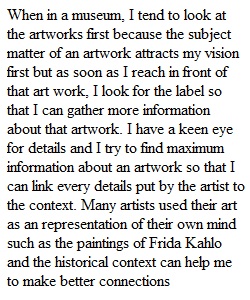


Q When you go into a museum and stand in front of an object, do you typically look at the work first or the label first? Discuss how your typical way of looking shapes the experience of a work of art. Depending on how you answered above, how would your viewing experience differ if you reversed the usual order, and looked at the label first or the work first? If you happen to prefer looking at the work first, how can a label be of benefit, or change your experience of a work? Or, has there ever been an instance in which you preferred seeing the label first? Describe that situation. Even if there were no label next to a work of art, are you (or anyone) still bringing some kind of context to the piece? If so, what kind of context is this that we bring (even without the label)? With everything above in mind, is it possible to have a "pure" experience of a work of art, free of predetermining influences? Your submission should be two to three paragraphs long.
View Related Questions